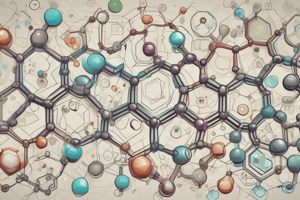Podcast
Questions and Answers
Which of the following statements accurately describes the role of heteroatoms in aromatic heterocycles?
Which of the following statements accurately describes the role of heteroatoms in aromatic heterocycles?
- Heteroatoms always contribute two π electrons to the aromatic system, regardless of the specific heterocycle.
- Heteroatoms may or may not contribute their lone pair to the aromatic system, depending on the specific heterocycle, impacting aromaticity and reactivity. (correct)
- Heteroatoms decrease the stability of the aromatic ring due to their electronegativity.
- Heteroatoms always increase reactivity towards electrophilic substitution due to their electron-donating nature.
Consider a novel heterocyclic compound containing a sulfur atom and exhibiting aromatic properties. Based on the general trends, what would be the MOST likely outcome?
Consider a novel heterocyclic compound containing a sulfur atom and exhibiting aromatic properties. Based on the general trends, what would be the MOST likely outcome?
- The compound will undergo electrophilic substitution reactions more readily compared to pyridine but less readily compared to pyrrole. (correct)
- The compound will be susceptible to oxidation at the sulfur atom, disrupting the aromatic system.
- The compound will be highly resistant to both electrophilic and nucleophilic substitution reactions.
- The compound will readily undergo electrophilic substitution reactions due to sulfur's strong electron-withdrawing effect.
A researcher aims to synthesize a furan derivative. Which of the following synthetic approaches would be MOST appropriate?
A researcher aims to synthesize a furan derivative. Which of the following synthetic approaches would be MOST appropriate?
- Reacting a 1,4-dicarbonyl compound with ammonia.
- Reacting an α-amino ketone with a β-keto ester.
- Treating a diene with a strong oxidizing agent.
- Dehydration of a 1,4-dicarbonyl compound. (correct)
How many π electrons are present in a molecule of quinoline?
How many π electrons are present in a molecule of quinoline?
A chemist is planning to synthesize pyrrole using the Paal-Knorr synthesis. Which of the following reactants would be MOST suitable?
A chemist is planning to synthesize pyrrole using the Paal-Knorr synthesis. Which of the following reactants would be MOST suitable?
Which of the following heterocycles contains a benzene ring fused to a pyrrole ring?
Which of the following heterocycles contains a benzene ring fused to a pyrrole ring?
A compound is named using the Hantzsch-Widman system as 'azepine'. What can be definitively concluded about this compound's structure?
A compound is named using the Hantzsch-Widman system as 'azepine'. What can be definitively concluded about this compound's structure?
Which of the following heterocycles is NOT aromatic?
Which of the following heterocycles is NOT aromatic?
Which set of reactants is specifically associated with the Gewald reaction for synthesizing thiophenes?
Which set of reactants is specifically associated with the Gewald reaction for synthesizing thiophenes?
Which of the following statements accurately describes the regioselectivity of electrophilic substitution in pyrrole?
Which of the following statements accurately describes the regioselectivity of electrophilic substitution in pyrrole?
In what position does electrophilic substitution primarily occur on pyridine, and under what conditions?
In what position does electrophilic substitution primarily occur on pyridine, and under what conditions?
What is a key characteristic of alkaloids that distinguishes them from other natural products?
What is a key characteristic of alkaloids that distinguishes them from other natural products?
How are terpenoids classified, and what is the fundamental building block from which they are derived?
How are terpenoids classified, and what is the fundamental building block from which they are derived?
Steroids are characterized by what structural feature, and what is their primary function in biological systems?
Steroids are characterized by what structural feature, and what is their primary function in biological systems?
What distinguishes carbohydrates from other classes of organic compounds in terms of elemental composition?
What distinguishes carbohydrates from other classes of organic compounds in terms of elemental composition?
What is the role of the shikimate pathway in biosynthesis?
What is the role of the shikimate pathway in biosynthesis?
Which of the following products are synthesized via the acetate pathway?
Which of the following products are synthesized via the acetate pathway?
What are the key initial products of the mevalonate pathway, and what class of natural products are they precursors to?
What are the key initial products of the mevalonate pathway, and what class of natural products are they precursors to?
Flashcards
Heterocyclic Compounds
Heterocyclic Compounds
Cyclic organic compounds with at least one non-carbon atom (N, O, or S) in the ring.
Pyrrole
Pyrrole
Five-membered aromatic heterocycle with one nitrogen atom.
Pyridine
Pyridine
Six-membered aromatic heterocycle with one nitrogen atom.
Indole
Indole
Signup and view all the flashcards
Hantzsch-Widman System
Hantzsch-Widman System
Signup and view all the flashcards
Oxa-
Oxa-
Signup and view all the flashcards
Aromatic Heterocycles Rule
Aromatic Heterocycles Rule
Signup and view all the flashcards
Paal-Knorr Synthesis
Paal-Knorr Synthesis
Signup and view all the flashcards
Gewald Reaction
Gewald Reaction
Signup and view all the flashcards
Hantzsch Pyridine Synthesis
Hantzsch Pyridine Synthesis
Signup and view all the flashcards
Pyrrole 2-position
Pyrrole 2-position
Signup and view all the flashcards
Pyridine 3-position
Pyridine 3-position
Signup and view all the flashcards
Natural Products
Natural Products
Signup and view all the flashcards
Alkaloids
Alkaloids
Signup and view all the flashcards
Terpenoids
Terpenoids
Signup and view all the flashcards
Steroids
Steroids
Signup and view all the flashcards
Carbohydrates
Carbohydrates
Signup and view all the flashcards
Biosynthesis
Biosynthesis
Signup and view all the flashcards
Study Notes
- Heterocyclic compounds are cyclic organic compounds containing at least one atom of an element other than carbon as a member of the ring.
- The heteroatom is usually nitrogen, oxygen, or sulfur.
Common Heterocycles
- Pyrrole, furan, and thiophene are five-membered aromatic heterocycles with one heteroatom.
- Pyridine is a six-membered aromatic heterocycle with one nitrogen atom.
- Indole is a bicyclic heterocycle consisting of a benzene ring fused to a pyrrole ring.
- Quinoline is a bicyclic heterocycle consisting of a benzene ring fused to a pyridine ring.
- Isoquinoline is an isomer of quinoline, with the nitrogen atom in a different position.
- Imidazole is a five-membered heterocycle with two nitrogen atoms.
- Thiazole is a five-membered heterocycle containing both nitrogen and sulfur atoms.
- Oxazole is a five-membered heterocycle containing both nitrogen and oxygen atoms.
- Pyrimidine is a six-membered heterocycle with two nitrogen atoms at positions 1 and 3.
- Purine is a bicyclic heterocycle consisting of a pyrimidine ring fused to an imidazole ring.
- Piperidine is a saturated six-membered heterocycle with one nitrogen atom.
- Tetrahydrofuran (THF) is a saturated five-membered heterocycle with one oxygen atom.
Nomenclature
- The Hantzsch-Widman system is a systematic nomenclature system for heterocycles.
- Prefixes indicate the heteroatoms present (oxa- for oxygen, thia- for sulfur, aza- for nitrogen).
- Stems indicate the ring size (irine for 3-membered, etine for 4-membered, ole for 5-membered, ine for 6-membered).
Aromaticity
- Aromatic heterocycles follow Hückel's rule (4n+2 π electrons).
- Pyrrole, furan, and thiophene are aromatic because they have 6 π electrons (4 from the double bonds and 2 from the heteroatom's lone pair).
- Pyridine is aromatic because it has 6 π electrons from the three double bonds. The nitrogen lone pair is not involved in the aromatic system.
Reactivity
- The reactivity of heterocycles depends on their electronic structure and aromaticity.
- Electron-rich heterocycles like pyrrole are more reactive towards electrophilic substitution.
- Electron-deficient heterocycles like pyridine are less reactive towards electrophilic substitution but can undergo nucleophilic substitution.
Synthesis of Pyrroles
- Paal-Knorr Synthesis: Reaction of a 1,4-dicarbonyl compound with ammonia or a primary amine.
- Knorr Pyrrole Synthesis: Reaction of an α-amino ketone with a β-keto ester.
Synthesis of Furans
- Paal-Knorr Synthesis: Dehydration of 1,4-dicarbonyl compounds.
Synthesis of Thiophenes
- Gewald Reaction: Reaction of a ketone, an aldehyde, elemental sulfur, and ammonia.
Synthesis of Pyridines
- Hantzsch Pyridine Synthesis: Reaction of an aldehyde, two equivalents of a β-keto ester, and ammonia.
Reactions of Pyrrole
- Electrophilic substitution occurs preferentially at the 2-position due to greater stability of the intermediate.
Reactions of Pyridine
- Undergoes electrophilic substitution at the 3-position, but requires harsh conditions.
- Undergoes nucleophilic substitution at the 2- or 4-position.
Natural Products
- Natural products are chemical compounds produced by living organisms.
- They can be isolated from plants, animals, and microorganisms.
- Many natural products have important biological activities and are used as pharmaceuticals.
Alkaloids
- Alkaloids are a class of naturally occurring organic compounds that contain at least one nitrogen atom.
- They are usually basic and have significant physiological effects.
- Examples include morphine, quinine, caffeine, and nicotine.
Terpenoids
- Terpenoids are a large and diverse class of natural products derived from isoprene units (C5H8).
- They are classified by the number of isoprene units they contain (e.g., monoterpenes (C10), sesquiterpenes (C15), diterpenes (C20)).
- Examples include limonene, menthol, pinene, and taxol.
Steroids
- Steroids are a class of lipids characterized by a four-ring structure.
- They have important hormonal functions and are involved in various physiological processes.
- Examples include cholesterol, testosterone, estrogen, and cortisol.
Carbohydrates
- Carbohydrates are organic compounds consisting of carbon, hydrogen, and oxygen, usually with a hydrogen-oxygen ratio of 2:1.
- They are classified as monosaccharides, disaccharides, oligosaccharides, and polysaccharides.
- Examples include glucose, fructose, sucrose, starch, and cellulose.
Amino Acids and Peptides
- Amino acids are the building blocks of proteins.
- They contain an amino group (-NH2) and a carboxyl group (-COOH) attached to the same carbon atom.
- Peptides are short chains of amino acids linked by peptide bonds.
- Proteins are large biomolecules consisting of one or more polypeptide chains.
Biosynthesis
- Biosynthesis is the process by which living organisms produce complex organic molecules from simpler precursors.
- The major biosynthetic pathways include the acetate pathway, the shikimate pathway, and the mevalonate pathway.
Acetate Pathway
- The acetate pathway is responsible for the biosynthesis of fatty acids, polyketides, and some terpenoids.
- It involves the condensation of acetyl-CoA units to form long carbon chains.
Shikimate Pathway
- The shikimate pathway is responsible for the biosynthesis of aromatic amino acids (phenylalanine, tyrosine, and tryptophan) and other aromatic compounds in plants and microorganisms.
Mevalonate Pathway
- The mevalonate pathway is responsible for the biosynthesis of terpenoids and steroids.
- It involves the conversion of acetyl-CoA to isopentenyl pyrophosphate (IPP) and dimethylallyl pyrophosphate (DMAPP), which are the building blocks of terpenoids.
Studying That Suits You
Use AI to generate personalized quizzes and flashcards to suit your learning preferences.




